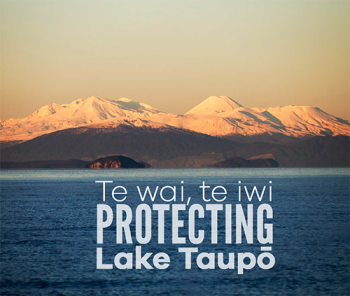On this page: About the project | Project story - read the booklet
About Protecting Lake Taupō
The Protecting Lake Taupō Project was New Zealand’s biggest ever environmental project when it first started. Several studies had shown that any serious decline in the water quality of Lake Taupō would be difficult to reverse. Failing to act would have economic, social and cultural consequences.
The project's goal became to prevent decline in water quality. To maintain the existing water quality, nitrogen output from existing land uses had to be reduced. And further land use intensification prevented.
This meant we needed to reduce the manageable load of nitrogen by at least 20 per cent.
To achieve this, the project group defined two objectives:
1. Introduce new policies and rules for land use and sewage treatment
This meant making a change to the Waikato Regional Plan. These new policies and rules, initially known as Waikato Regional Plan Variation 5, were successfully introduced and now form part of the Waikato Regional Plan. New rules to protect the lake include:
- limits on the annual average amount of nitrogen leached from rural land use activities – dairy and drystock farming will require resource consents
- limits on the amount of nitrogen leached from new wastewater discharges (on site or community systems)
- requiring a high standard of nitrogen removal from wastewater systems near to the lakeshore
- allowing nitrogen trading between properties to provide flexibility for landowners to meet the new rule requirements and to enable optimal economic outcomes under the nitrogen cap.
2. Remove 170 tonnes of nitrogen in the catchment by 2018
The Lake Taupō Protection Trust was formed in 2007 with the overall goal of reducing the amount of manageable nitrogen entering the lake by at least 20 per cent (170 tonnes per year). Central government, Waikato Regional Council and Taupō District Council ultimately contributed $79.2 million excl. GST to support the conversion of high nitrogen-leaching land uses into low nitrogen-leaching land uses over a 15 year period. The fund has also supported research, new technologies and education about farm systems in the Lake Taupō catchment.
See the timeline for the project's key events and achievements.
Project story
 He mahi tahi kia tiaki pai ai ngā wai Māori o te tupuna roto te putake o te horopaki haumaru i te roto o Taupō Ko te whakatinanatanga o te oati i oatitia e Ngāti Tūwharetoa, ētahi kaipāmu, kai pupuri whenua me te hapori whānui, ngātahi me ngā kaunihera o te rohe me te Kāwanatanga, i tutuki ai tētahi kaupapa whakaora i te roto.
He mahi tahi kia tiaki pai ai ngā wai Māori o te tupuna roto te putake o te horopaki haumaru i te roto o Taupō Ko te whakatinanatanga o te oati i oatitia e Ngāti Tūwharetoa, ētahi kaipāmu, kai pupuri whenua me te hapori whānui, ngātahi me ngā kaunihera o te rohe me te Kāwanatanga, i tutuki ai tētahi kaupapa whakaora i te roto.
The story of protecting Lake Taupō is about people working together to safeguard the clean waters of a treasured lake. Through commitment from Ngāti Tūwharetoa, other farmers, landowners and the community at large, alongside central and local government, a project to protect the lake was successfully undertaken.
